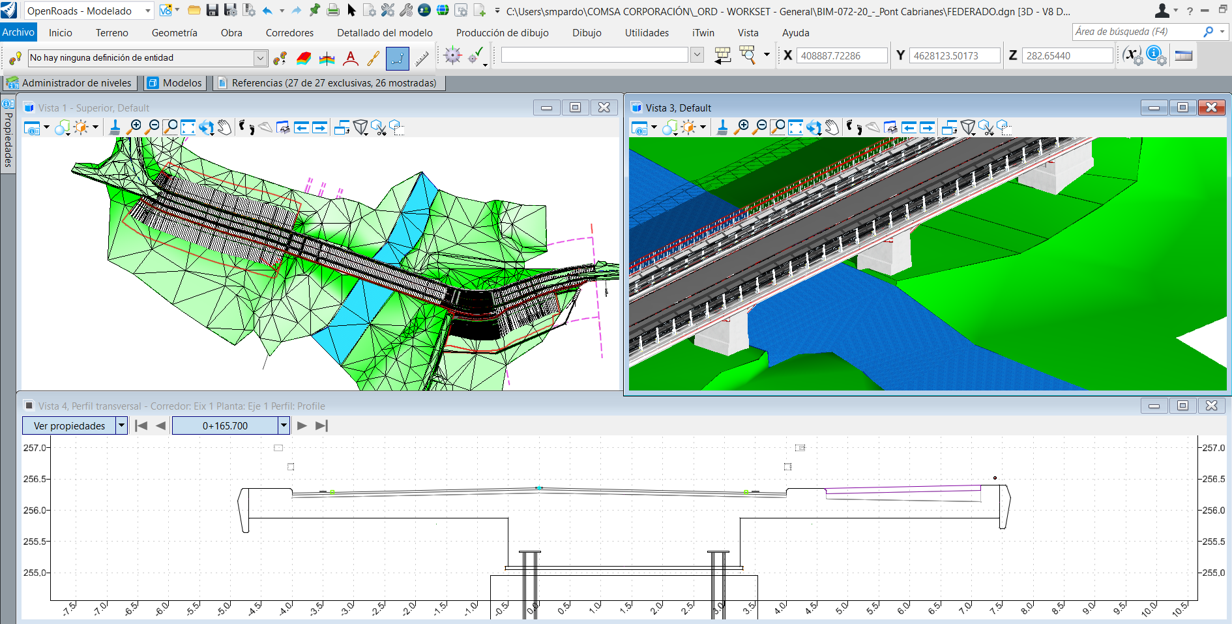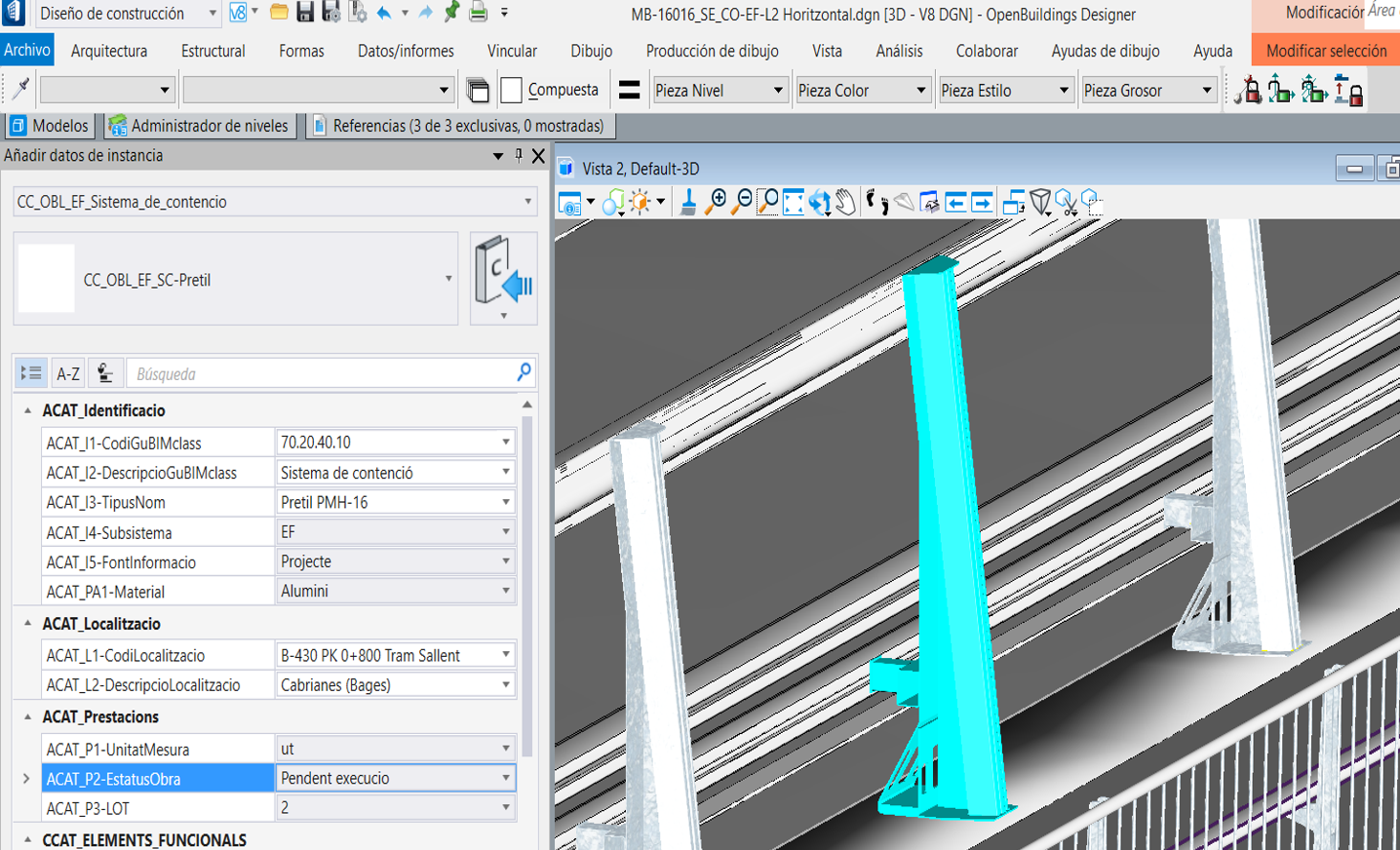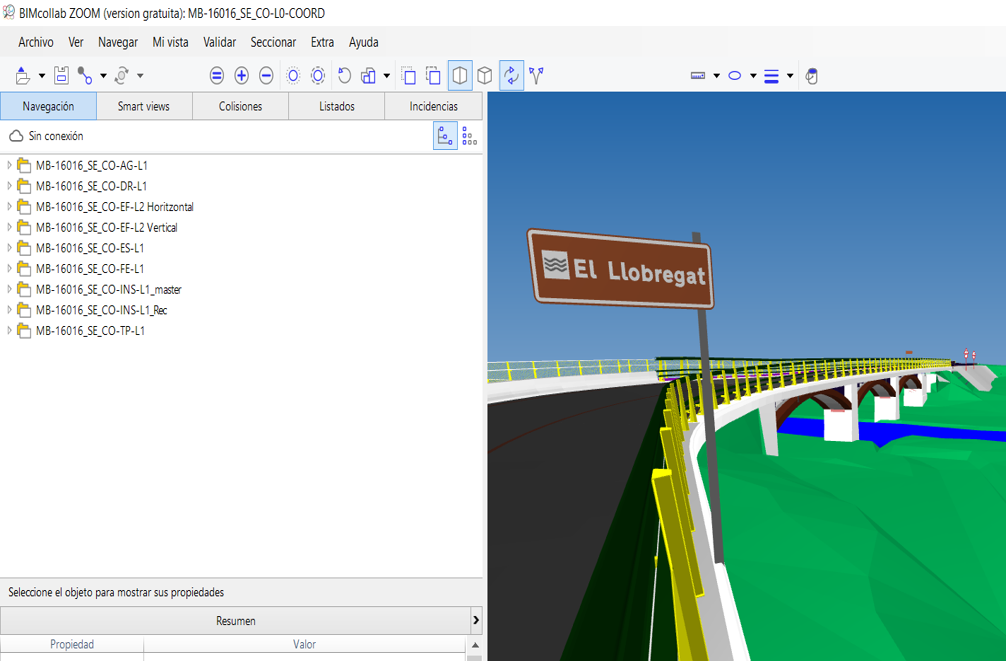Comsa Digitizes Renovation of Century-old Bridge in Cabrianes, Barcelona
Project
Published by:
Datasheet
Description
Bentley’s Integrated BIM Applications Optimize Design and Construction Monitoring, Reducing On-site Errors
Reconstructing a Historic Bridge Over the Llobregat River
Located in the Bajes region of Barcelona, the Cabrianes Bridge is a century-old structure spanning the Llobregat River along the Carretera B-430 road. To improve safety, service, and traffic flow, as well as to accommodate pedestrian and cyclist mobility, the bridge and roadway access points are being renovated and modernized. The EUR 2.4 million project consists of widening the bridge from 6 meters to 12 meters to include two-way vehicle traffic lanes and a pavement for nonvehicular transport. It also includes constructing a new deck supported by a central arch.
“The works will improve the level of service and favor safety and fluidity in driving, as well as the mobility of pedestrians and cyclists,” said Santiago Martinez Pardo, surveyor and BIM modeler of linear infrastructure at Comsa. With a commitment to continually improving in construction processes and implementing an innovative project management model, Comsa is delivering the refurbishment and reconstruction project using a BIM methodology.
Understanding Design and Construction Schemes
The bridge features existing piles, walls, and slabs that need refurbishing and were poorly maintained. Additionally, the newly built infrastructure needs to be integrated with the existing renovation works. “The remodeling of the bridge combines existing renovated elements with new ones,” said Pardo. Faced with this complex integration challenge, Comsa realized the need to create a digital 3D model to better convey and understand the design and construction scheme. During the initial project phase, the bridge had not been modeled, making it difficult for engineers and construction staff to visualize and fully grasp the design intent and construction plans. “Although the blueprints, cross-sections, and longitudinal plans are intuitive, especially for experienced construction staff, this was not enough to provide a complete view of the project in the initial phase,” said Pardo.
With a multidiscipline team dedicated entirely to the development and implementation of BIM, Comsa set out to model the existing site and structure and, based on that model, generate an integrated project model for the bridge extension and accesses. They wanted to digitize project execution, coordinating layout and geometry of the structure, streamlining workflows, and monitoring construction progress. Although they used a third-party software during the bidding process, the software did not meet their subsequent modeling needs. To achieve their digital goals and implement lifecycle, collaborative BIM processes, Comsa needed integrated 3D modeling technology and an open connected data environment to make the model accessible to the entire team.
Establishing a Collaborative 3D Modeling Environment
Comsa selected MicroStation, OpenRoads, and OpenBuildings to establish a collaborative 3D modeling environment, enabling them to model the different geological and structural elements and link them in an integrated BIM model. “I used Bentley products because they include the most appropriate tools and workflows for a project of this size: topography, road layout, 3D modeling of the structure, metadata, and export to IFC. In addition, I have been familiar with Bentley technology for more than 20 years,” said Pardo. The different discipline-specific models are integrated into a unified 3D project model using [p]OpenBuildings, and then shared in an open file format among the team for a holistic view and better understanding of the project works. Based on the BIM model, the team could accurately obtain earthworks and surface volumes, then identify and resolve differences between the theoretical design and the executed version.
Additionally, the interoperability of Bentley software with other technology applications allowed the team to access and manipulate the federated model in an open BIM format, as well as digitally track monthly progress of on-site works. Working in a collaborative, dynamic modeling environment, Comsa was able to graphically check whether the different component works would be correctly executed and remotely monitor the construction process. The BIM model was key to visualizing the finished project before it even began, and the final model represents the project as it was actually executed. “The 3D model helped us understand how all the pieces of the puzzle fit together,” said Pardo.
BIM Sets New Standards
“Modeling the different objects and linking them in the overall model enabled us to check some geometrical errors that would have gone unnoticed until they were made on site,” said Pardo. Working with the 3D models using Bentley’s BIM technology, Comsa could digitally see any mistakes and identified potential costly errors prior to construction. Sharing the BIM model on a monthly basis made it easy for all participants to see the progress of the project. The integrated digital solution facilitated better understanding of the project and optimized construction. It also helped optimize time and resources, reduce pollution, and improve overall project execution. The 3D model will be used for continued asset maintenance and management.
“MicroStation, OpenRoads Designer, and OpenBuildings Designer, combined with BIM methodology, have facilitated understanding of the project, the monitoring of the construction, and the maintenance of the asset,” said Pardo. This project has highlighted the pillars of BIM methodology for Comsa—including transparency, collaboration, and communication—to provide the best client service. Working in a collaborative BIM environment helps with the understanding, arrangement, and execution of complex engineering projects. As a company, BIM allowed Comsa to not only successfully execute this bridge renovation, but also to create digital libraries that will serve as the basis for other projects, setting new corporate digitization standards for project delivery.
Project Summary
- Organization: Comsa Corporación
- Solution: Bridges and Tunnels
- Location: Cabrianes, Barcelona, Spain
Project Objectives:
- To renovate and modernize a century-old bridge structure to accommodate additional vehicular traffic, pedestrians, and bicycles.
- To use the 3D model to digitize workflows, construction monitoring, and asset management.
- Project Playbook: AutoPIPE, MicroStation, OpenBuildings, OpenRoads
Fast Facts
- The project consists of widening the bridge from 6 meters to 12 meters to include two-way traffic lanes.
- Initially, the project was not modeled, and paper plans failed to provide a holistic view of the project.
- Using Bentley applications, Comsa established a collaborative 3D BIM model for better understanding of design and construction plans.
ROI
- Using a digital, visual 3D model, Comsa identified potentially costly errors prior to on-site construction.
Author: Amy Heffner is a director of product marketing at Bentley Systems. She can be reached at [email protected].
Type of Work
- Civil work
Companies collaborating in the project
- Comsa Corporación
















